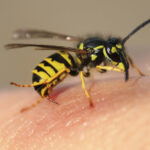How Can We Help?
How do wasps start a new nest each year?
Every year, new wasp nests get started by a lone queen who made it through the winter. In early spring, she wakes up from hibernation and starts looking for a good spot to build her nest. She likes sheltered places like eaves, attics, tree branches, and even underground burrows. Once she finds the right spot, she begins building the nest using wood fibers that she chews into a papery pulp, forming a small structure with a few cells for her first eggs.
 The queen keeps expanding the nest while taking care of these initial eggs. When they hatch, she feeds the larvae with chewed-up insects. After they pupate, these larvae turn into worker wasps. These workers then take over the jobs of finding food, expanding the nest, and looking after the next broods so the queen can just focus on laying eggs.
The queen keeps expanding the nest while taking care of these initial eggs. When they hatch, she feeds the larvae with chewed-up insects. After they pupate, these larvae turn into worker wasps. These workers then take over the jobs of finding food, expanding the nest, and looking after the next broods so the queen can just focus on laying eggs.
As the season goes on, the nest gets much bigger and more crowded, with worker wasps constantly adding new cells and layers to fit the growing colony. By late summer, the nest might house thousands of wasps. But each winter, the nest is left behind, and the cycle starts all over again the next spring with new queens setting up their nests.
What is the role of the queen wasp in the colony?
The queen wasp is key to the colony, mainly focusing on reproduction and setting up the nest. At the start of the season, she comes out of hibernation and picks a good spot to build the nest. She begins by chewing wood fibers into a papery pulp to create the first cells, where she lays her initial eggs. These eggs hatch into larvae, which she feeds and takes care of until they become worker wasps.
Once the first generation of workers is grown, they take over the duties of finding food, expanding the nest, and caring for the larvae. This shift allows the queen to focus solely on laying eggs, ensuring the colony keeps growing. The queen's job of laying eggs is crucial, as she needs to continuously produce eggs throughout the season to maintain and grow the colony's population.
The queen also releases pheromones that help regulate the behavior and functioning of the colony, keeping everything running smoothly among the workers. By the end of the season, she produces new queens and male wasps, which will mate and ensure the species survives into the next year. Hence, the queen's role is central to the colony's structure, growth, and long-term survival.
Where do queen wasps hibernate?
Queen wasps hibernate in sheltered, protected spots to survive the cold in winter and start new colonies in the spring. After mating in late summer or early fall, fertilized queens look for good hibernation sites. These sites are usually secluded and offer insulation from the cold, like under loose bark, in rotting logs, within tree stumps, or in the crevices of buildings. Queens might also choose attics, sheds, garages, or other human-made structures where they can find small, quiet spaces.
The chosen hibernation spot needs to provide a stable environment where the queen can stay dormant and protected from harsh weather, predators, and other threats. During hibernation, the queen goes into a state called diapause, which significantly slows her metabolism to save energy. This lets her get through the winter months until warmer temperatures signal the arrival of spring.
When she wakes up from hibernation, the queen emerges to find a new nesting site, starting the process of building and growing a new colony. Picking a secure hibernation spot is crucial for the queen's survival and the successful continuation of the wasp colony.
How do wasps defend their nests?
Wasps use a bunch of tactics to defend their nests from predators and intruders, counting on their aggressive behavior and coordinated colony response. When a threat gets close, wasps release alarm pheromones to alert and mobilize the colony. This chemical signal triggers a defensive swarm, with multiple wasps coming out to confront the intruder. They use their powerful stingers to deliver painful stings, injecting venom that can scare off or incapacitate the threat. Wasps can sting multiple times, making them pretty effective defenders.
Wasps also show territorial behavior, patrolling the area around their nest and attacking any perceived danger. Their sharp sense of smell and ability to recognize familiar and unfamiliar scents help them identify potential threats. The physical structure of the nest also helps with defense, as many species build nests in elevated or hidden spots like eaves, tree branches, or underground burrows, making it harder for predators to reach them.
Some wasp species build their nests with materials like paper or mud, which offer camouflage and strength, further boosting their defensive capabilities. Through a mix of chemical communication, aggressive behavior, and strategic nest placement, wasps effectively protect their colonies from a wide range of threats, ensuring the survival and stability of their population. Hiring professionals like us here at Youngs Pest Control can assist you in the eradication of wasps effectively and safely. So, if you encounter a wasp nest on your property, it's best to leave the removal to trained experts to avoid any stinging incidents.
